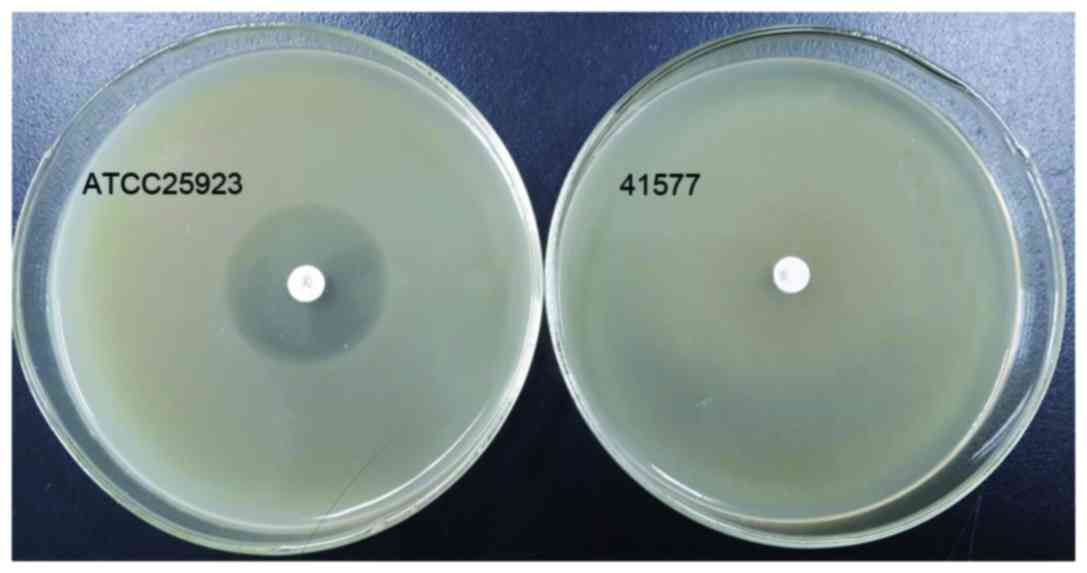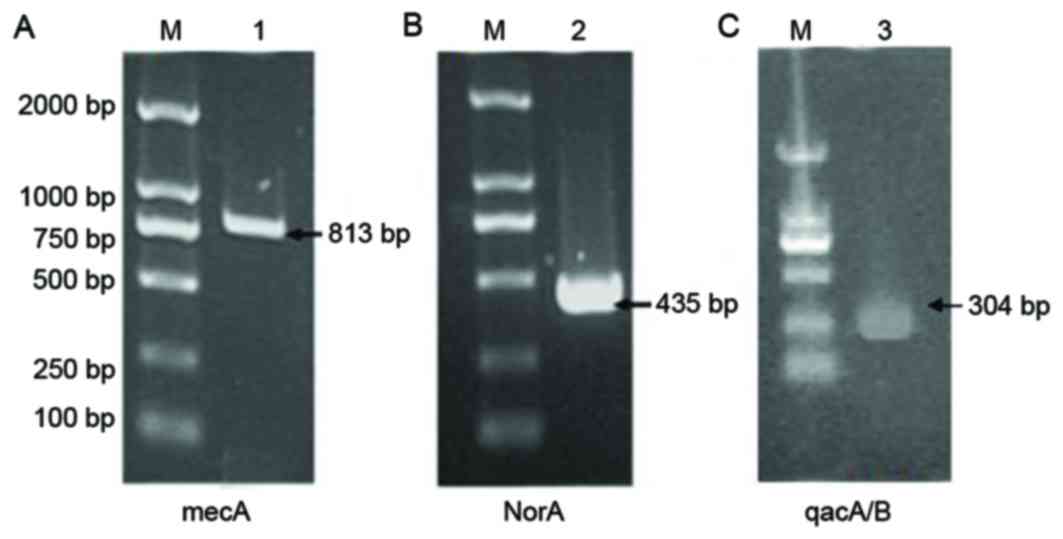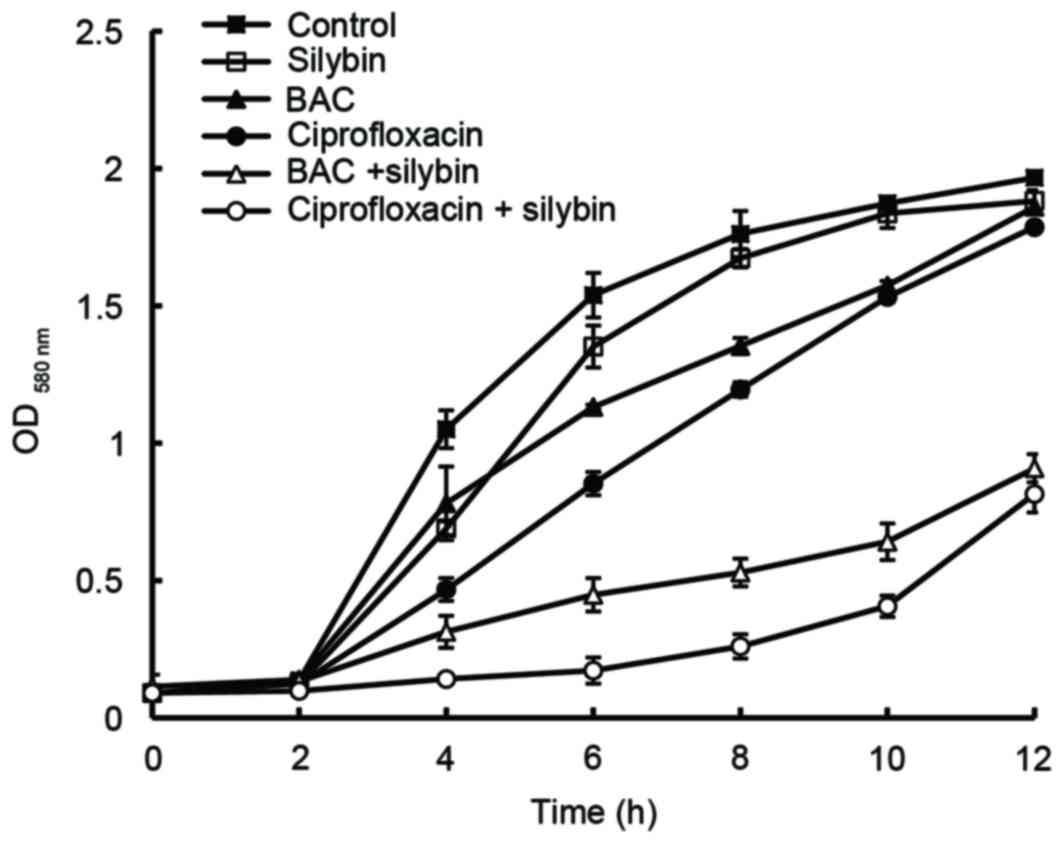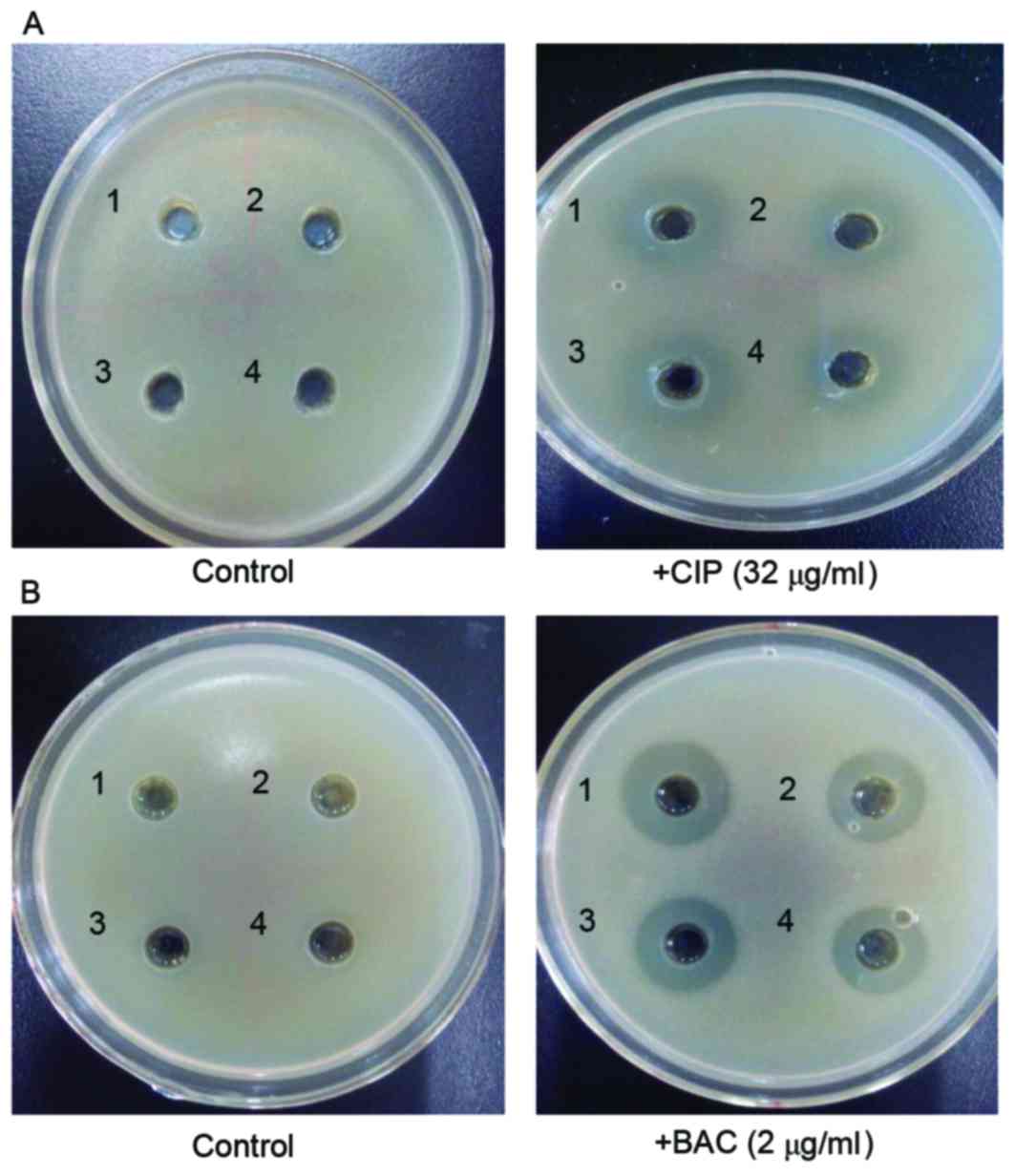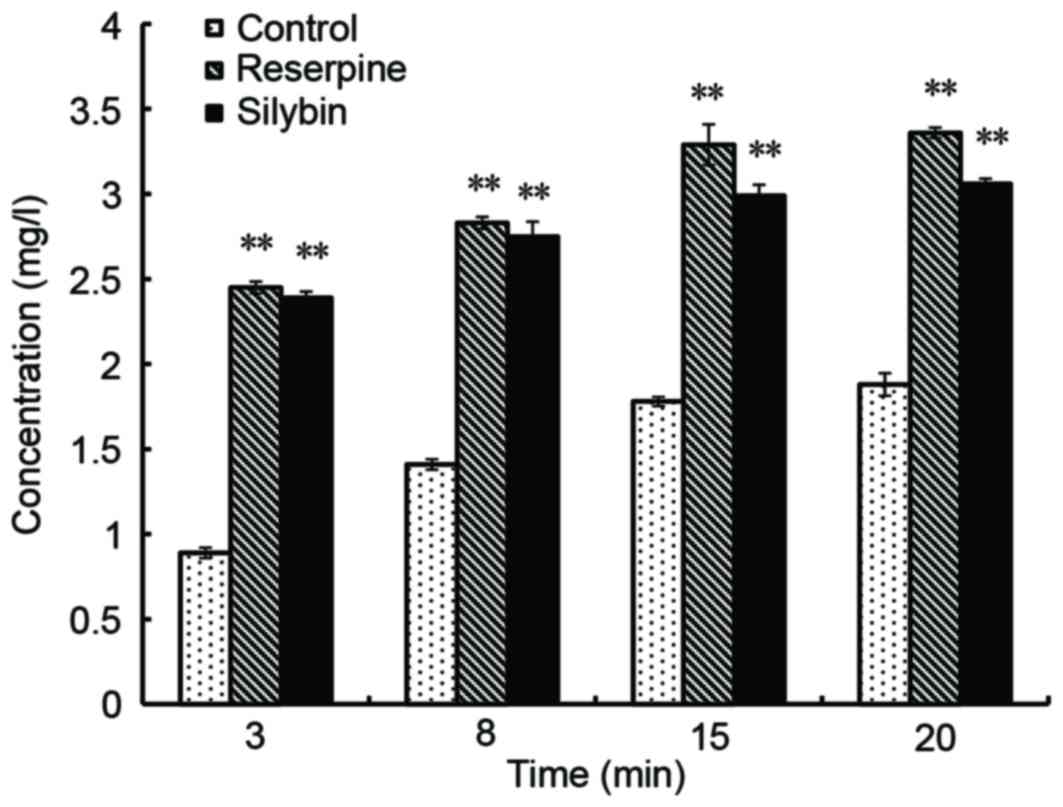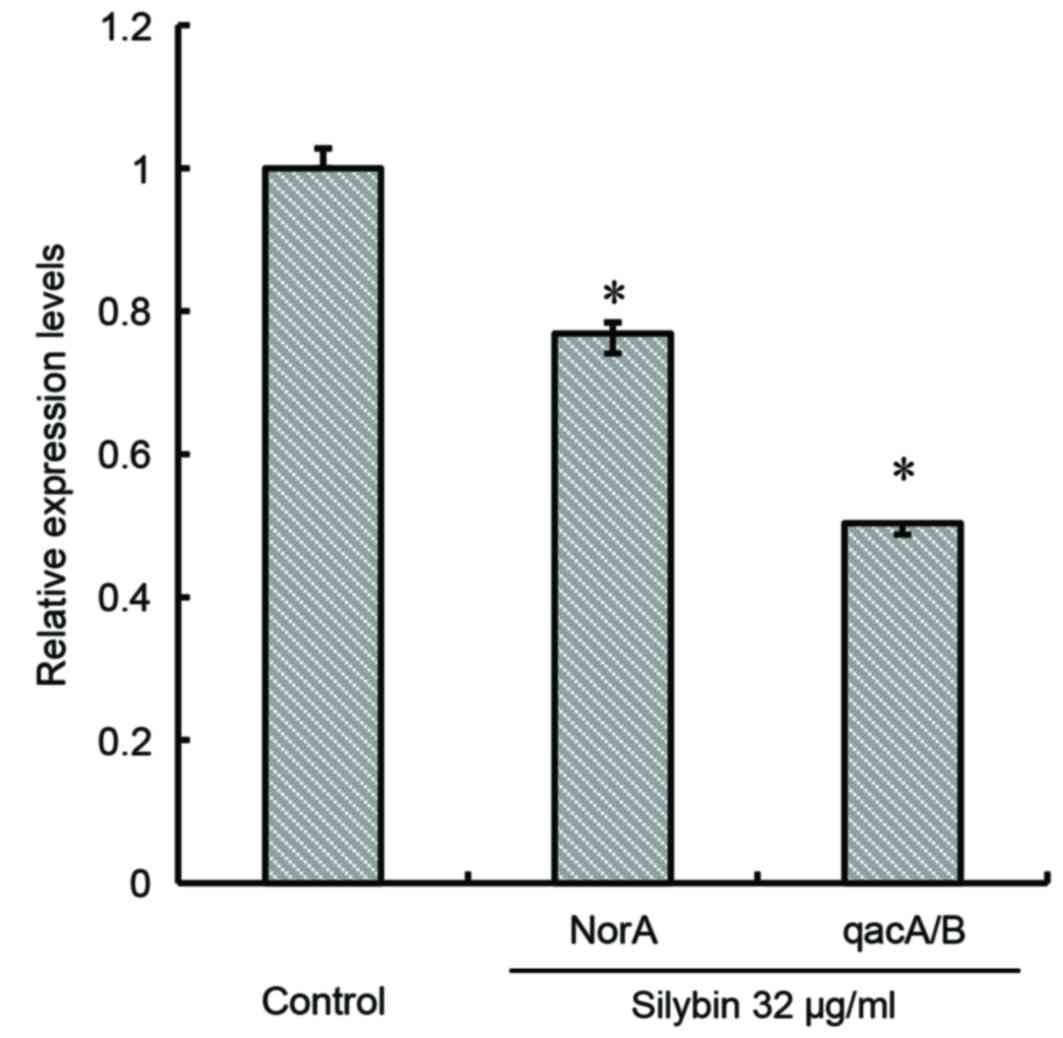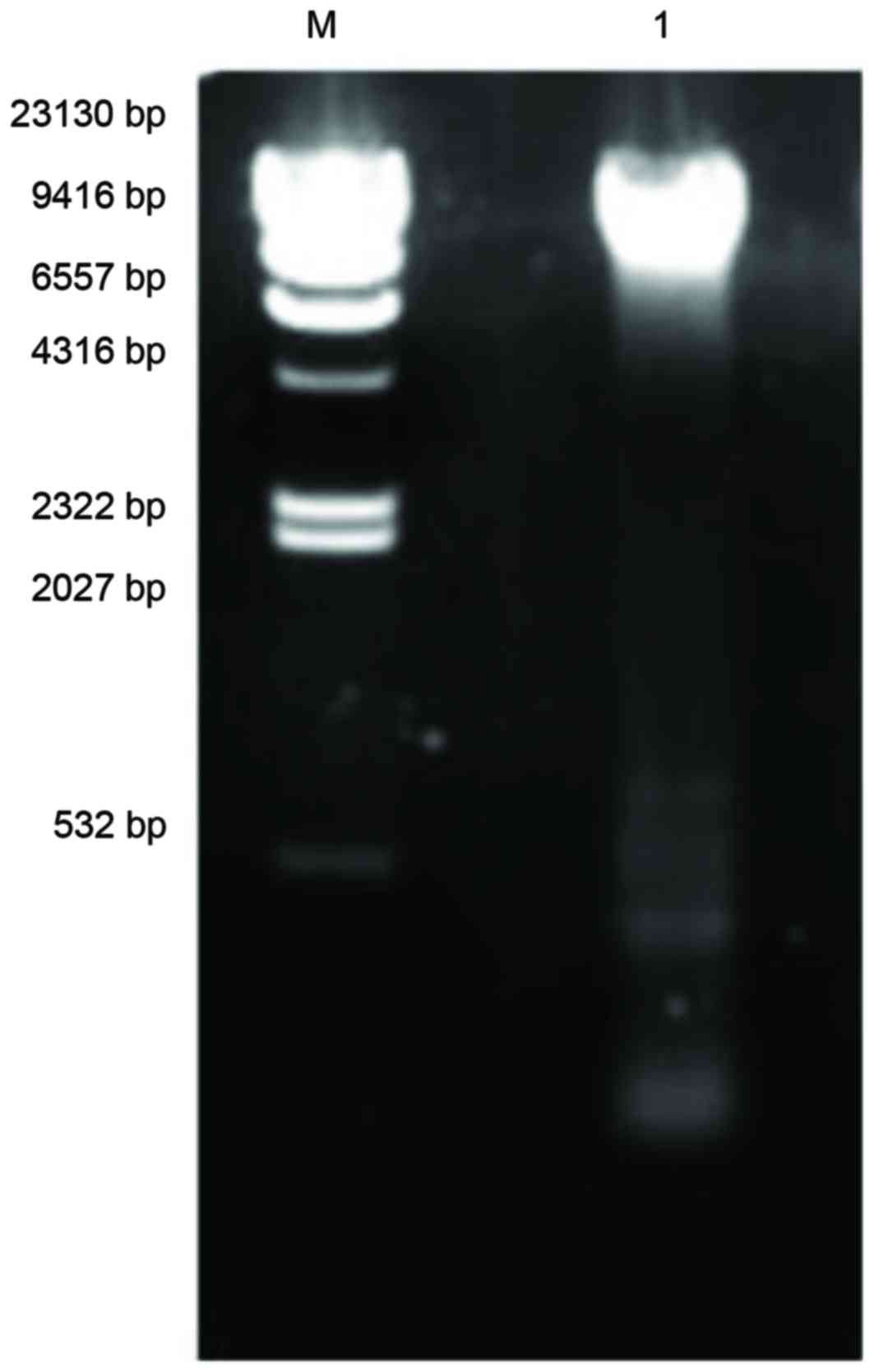Inhibitory effects of silybin on the efflux pump of methicillin‑resistant Staphylococcus aureus
- Authors:
- Published online on: May 16, 2018 https://doi.org/10.3892/mmr.2018.9021
- Pages: 827-833
-
Copyright: © Wang et al. This is an open access article distributed under the terms of Creative Commons Attribution License.
Abstract
Introduction
Methicillin-resistant Staphylococcus aureus (MRSA) is a S. aureus-associated infection that has been reported worldwide, which has now become one of the most important pathogens in nosocomial and communal infections (1). The mortality rates associated with MRSA infection are as high as 63.1%, and nosocomial infections account for >60–80% of cases (2,3). Previous research has revealed that the bacterial efflux system is the main cause of multidrug resistance (MDR), and therefore identifying effective efflux pump inhibitors that prevent the bacteria from expelling the drugs out of the cells is a valid method of targeting bacterial MDR (4). A number of efflux pump inhibitors have been reported, including reserpine, LY35979, glyburide and phenothiazine-metal complexes, cyanide chlorobenzene hydrazone and verapamil, all of which inhibited the bacterial efflux system and restored bacterial sensitivity to antibiotics and other drugs (5,6). However, these drugs exhibit several side effects that limit their use for clinical application. Medicinal herbs used in traditional Chinese medicine tend to have fewer side effects, and therefore recent research has focused on the screening of efflux pump inhibitors from these herbs. Extracts from certain herbs have been demonstrated to inhibit the efflux pump of S. aureus, including Fritillaria, Belamcanda chinensis, Andrographis paniculata (7). Silybin is a flavonolignan component of the extract from the milk thistle seed, termed silymarin. Silybin is present in silymarin as an approximately equal-molar mixture of two diastereoisomers: silybinA and silybinB (Fig. 1). To date, silybin has been reported to have anti-oxidative, anticancer, antibacterial and anti-osteoporosis activities (8); however, the exact mechanism by which silybin inhibits MDR to improve the effectiveness of antibiotics remains unclear. Molnar et al (9) demonstrated that silybin acted as an efflux pump inhibitor as it inhibited the efflux pump of S. aureus. In the present study, the mechanism by which silybin inhibits the MRSA efflux system was investigated by performing antimicrobial susceptibility testing, the double-plate method, fluorescence spectrophotometry, plasmid elimination and polymerase chain reaction (PCR) assays.
Materials and methods
Materials
MRSA41577 was provided by the Dalian Municipal Central Hospital (Dalian, Liaoning, China). The quality control strain, S. aureus ATCC25923 was provided by the Chinese Medical Culture Collection Center, National Center for Medical Culture Collections (Beijing, China; www.cmccb.org.cn/cmccbnew). Ciprofloxacin (CIP) and benzalkonium chloride (BAC; 40%) were purchased from Dalian Sanxing Wuzhou Chemical Co., Ltd. (Dalian, China; sanxingwuzhou.1688.com). Cefoxitin paper (30 µg/piece), reserpine and silybin were purchased from Novozymes Biotechnology Co., Ltd. (Shenyang, China). Primers and PCR reagents were purchased from Takara Biotechnology Co., Ltd. (Dalian, China). 2,3,5-Triphenyltetrazolium chloride (TTC) was purchased from Sangon Biotech Co., Ltd. (Shanghai, China).
Detection of drug resistance in bacterial strains
Drug resistant strains of bacteria were detected using the cefoxitin paper method of the American Association of Clinical and Laboratory Standards Institute (CLSI2014) (10). S. aureus ATCC25923 was used as the quality control strain.
PCR amplification of the drug resistance and efflux pump genes
MRSA41577 cells were cultured in lysogeny broth (LB; Sangon Biotech Co., Ltd.) to the logarithmic phase and aliquots (3–6 ml) of the culture were then centrifuged at 3,000 × g for 5 min at 4°C, and the supernatant was discarded. Genomic DNA was extracted from the cell pellets according to previously described methods (11,12). Primers specific for the penicillin binding protein 2 (mecA), an MRSA-inherent gene, quinolone resistance protein NorA (norA), a surrogate for measuring resistance to fluoroquinolone antibiotics, and quaternary ammonium resistance proteins A/B (qacA/B) genes, representative of MRSA resistance to quarternary ammonium antibiotics (Table I), were designed according to the sequences published in GenBank (www.ncbi.nlm.nih.gov/genbank) using Primer Premier 5.0 (Premier Biosoft International, Palo Alto, CA, USA; www.premierbiosoft.com) software and reference documents. Premix Taq (Takara Taq Version 2.0 plus dye; Takara Biotechnology Co., Ltd.) was used for the PCR analysis. PCR was performed with the following thermocycling conditions: Initial denaturation at 94°C for 5 min, followed by 30 cycles of 94°C for 30 sec, 55°C 30 sec and 72°C for 45 sec, and a final extension at 72°C for 10 min. The amplified products were visualized by 1% agarose gel electrophoresis. The DNA samples were loaded onto a 1% agarose gel and visualized using ethidium bromide and a transilluminator.
Table I.Sequences of the primers used for reverse transcription-quantitative polymerase chain reaction. |
Antimicrobial susceptibility testing
The minimum inhibitory concentrations (MICs) of CIP and BAC were determined using a two-fold dilution method according to the National Committee for Clinical Laboratory Standards guidelines (13). A total of 100 µl MRSA41577 (105 cfu/ml) was mixed with different concentrations of CIP (16, 32, 64 and 128 µg/ml) and BAC (0.5, 1, 2 and 4 µg/ml) in a 96-well plate and incubated at 37°C on a shaking plate (120 rpm) for 24 h. MRSA41577 cultured with 0 µg/ml CIP and BAC were used as a control. Following incubation, 20 µl 20% TTC was added to each sample and the plate was further incubated at 37°C in the dark for 4 h.
In order to elucidate the effect of CIP and BAC activity in the presence of silybin, various concentrations of silybin (16, 32, 64 and 128 µg/ml) were applied to 100 µl MRSA41577 (105 cfu/ml) cells alone or in combination with either CIP (16, 32, 64 and 128 µg/ml) or BAC (0.5, 1, 2 and 4 µg/ml), in 96-well plates. The plates were incubated at 37°C for 24 h. Following incubation, 20 µl 20% TTC was added to each sample and the plate was further incubated at 37°C in the dark for 4 h. A blank control and a positive control were also prepared. The blank control was comprised of MRSA41577 cells cultured in culture media only without CIP, BAC or silybin treatment. Positive control MRSA4157 cells were cultured with reserpine only. The MIC of CIP to MRSA 41577 was 12 µg/ml. When the silybin was added, the MIC of CIP decreased notably, demonstrating that the sensitivity of MRSA41577 to CIP was improved. Each experiment was repeated three times.
Determination of the synergistic effect of silybin
Silybin, CIP and BAC were added alone or in combination (CIP or BAC with silybin) to a sample of 20 ml MRSA41577 (105 cfu/ml). The final concentrations of silybin, CIP and BAC were 32, 16 and 0.24 µg/ml, respectively. The samples were incubated at 37°C on a shaking plate set at 120 rpm. The optical density values of the samples were continuously measured at 580 nm over a 12-h period. The control was comprised of MRSA41577 cells cultured in culture media only without CIP, BAC or silybin treatment. The experiment was repeated three times.
Effect of silybin on the efflux pump of MRSA
The double-plate method (14) was used to evaluate the effect of silybin on the efflux plump in MRSA. Briefly, four LB-agar plates were prepared, each containing 20 ml of the LB solid medium. To two of the plates, 200 µl of the MRSA41577 culture containing 1% agar was poured on top and allowed to solidify. To the other two plates, the same volume of MRSA41577 culture containing 1% agar was added, with the addition of either 32 µg/ml CIP or 2 µg/ml BAC. Following solidification, four holes, each with a diameter of 6 mm, were punched into the plate. Two of the holes were filled with 100 µl of a solution containing silybin (60 and 80 µg, respectively), while the other two holes were filled with 100 µl of a solution containing reserpine (60 and 80 µg, respectively). The plates were incubated at 37°C for 24 h, and the zone of bacteriostatic activity around each hole was then observed. A vernier caliper was used to accurately measure bacteriostatic circle, with the expected result that a higher concentration of the drug leads to an increased diameter of the bacteriostatic circle.
Accumulation of CIP dynamics test
Following treatment with 32 µg/ml silybin for 16 h, 20 ml MRSA41577 (105 cfu/ml) cells were harvested and washed with phosphate-buffered saline (PBS; pH 7.4). The cells were then resuspended in PBS (pH 7.4) and incubated at 37°C for 10 min. CIP was added to the cells to 20 µg/ml, which was followed by further incubation at 37°C. Aliquots (0.5 ml) of the cell suspension were removed at 3, 8, 15 and 20 min intervals during incubation. The samples were centrifuged (at 4°C and 3,000 × g for 5 min) and the cell pellets were each resuspended in 1 ml glycine-hydrochloric acid (0.1 mol/l; pH 3.0). All samples were incubated at 25°C for 2 h, followed by centrifugation (at 4°C and 3,000 × g for 5 min). The supernatants were removed for fluorescence analysis using emission and excitation wavelengths of 450 and 382 nm, respectively. The positive control in this experiment contained 20 µg/ml reserpine as an efflux pump inhibitor and the negative control contained no drugs.
Assessing the effect of silybin on MRSA41577 norA and qacA/B expression levels
20 ml MRSA41577 (105 cfu/ml) was cultured in the absence or presence of 32 µg/ml silybin at 37°C to the logarithmic phase. Aliquots (4–6 ml) of the culture were then centrifuged at 10,000 × g and 4°C for 1 min to harvest the cells. Total RNA was extracted from the cells using the TRIzol method (Takara Biotechnology Co., Ltd.). RNA concentration was measured with a nucleic acid protein analysis instrument (Cole-Palmer Ltd., Stone, UK). The RNA was used as a template to synthesize the cDNAs of the norA and qacA/B genes by two-step reverse transcription, using RNA to cDNA EcoDry™ Premix (Oligo dT) (Takara Biotechnology Co., Ltd.). The 16S RNA was used as the internal reference gene. The temperature protocol was as follows: 42°C for 60 min, followed by heating at 70°C for 10 min. Amplification was performed using the following conditions: Initial denaturation at 95°C for 10 min, followed by 40 cycles of 95°C for 30 sec, 95°C for 5 sec and 53°C for 30 sec. At the end of amplification, the samples were then subjected to a further cycle of 95°C for 15 sec, 60°C for 30 sec and 95°C for 15 sec with continuous fluorescence monitoring using Thermal Cycler Dice Real Time System II (Takara Biotechnology Co., Ltd.). The primers used were: norA (F: 5′GAG TGC TGG TAT GGT AAT GCC3′; R: 5′CCCTGGTCCTAAAATGAATCC3′); qacA/B (F: 5′TTGAGCAATTTTCATGGCACTC3′; R: 5′CCCACGAGTGAGACTTTTCTTTT3′); and 16S RNA (F: 5′GCTCGTGTCGTGAGATGTTGG3′; R: 5′TTTCGCTGCCCTTTGTATTGT3′). The relative expression levels of norA and qacA/B genes were calculated using the equation 2−ΔΔCq (15), where ΔCq was measured by subtracting the Cq of the 16S RNA value from the Cq value of norA or qacA/B. The experiment was repeated three times.
Silybin elimination MRSA41577 plasmid assay
MRSA41577 cells were cultured at 37°C to the logarithmic phase and aliquots (3–4 ml) of the culture were centrifuged at 3,000 × g for 1 min at 4°C to harvest the cells for plasmid DNA extraction, according to the method described by Chen et al (16). The extracted plasmid DNA was subjected to 1% agarose gel electrophoresis and visualized using ethidium bromide and a transilluminator.
MRSA41577 cells were cultured at 37°C in LB medium containing 32 µg/ml silybin to the logarithmic phase. A total of 200 µl cell suspension (109 cfu/ml) was spread onto an LB agar plate and then incubated at 37°C for 24 h. Single colonies (~300) were randomly picked and replica-plated onto new plates containing 0 or 2 µg/ml BAC. The two plates were incubated at 37°C for 24 h and the number of colonies observed on the plates were counted to calculate the plasmid elimination rate. Plasmid elimination rate (%)=(A/B) × 100; where A was the number of colonies observed on the plate containing common culture medium without antibiotics, but, could not grow in the selective medium containing antibiotics and B is the number of colonies that were observed on the plate containing common culture medium without antibiotics (17).
Statistical analysis
Statistical analysis was performed using SPSS software version 13.0 (SPSS, Inc., Chicago, IL, USA). Data are expressed as the mean ± standard deviation and were analyzed by one-way analysis of variance followed by least significant difference post hoc test (equal variances). P<0.05 was considered to indicate a statistically significant difference.
Results
Drug resistance in the strains
The quality control strain ATCC25923 was sensitive to cefoxitin, however, MRSA41577 was resistant to it. The diameter of the inhibition zone of ATCC25923 was 29 mm (Fig. 2). According to the CLSI2014 criteria, bacterial strains that produce a bacteriostatic zone of <21 mm are considered to be resistant MRSA strains, while strains that produce a bacteriostatic zone of >22 mm are regarded as sensitive strains. Thus, the MRSA41577 strain used in the present study was regarded as a MRSA resistant strain.
Screening of MRSA41577 resistant and efflux pump genes
The mecA gene has been become a molecular index for detecting MRSA, and the norA and qacA/B genes are considered to be significant contributors to antibiotic resistance (18). The mecA gene was detected in MRSA41577 cells (Fig. 3A), further confirming that it was a MDR bacterial strain. In addition, the efflux pump genes norA (Fig. 3B) and qacA/B (Fig. 3C) were also detected in these cells.
Synergistic effect of silybin with CIP and BAC
Silybin had no bacteriostatic effect on MRSA41577 at the range of concentrations tested (16 to 128 µg/ml). The MICs of CIP and BAC were 128 and 4 µg/ml, respectively. When silybin was combined with CIP and BAC, the resulting mixture reduced the MIC of CIP and BAC. Following treatment with 32 µg/ml silybin, the MIC of CIP was reduced by 4-fold and the MIC of BAC was reduced by 2-fold when compared with treatment without silybin (Table II). When these drugs were used individually, the growth curves obtained for MRSA41577 were comparable to that produced by the control (Fig. 4). However, when silybin was used in combination with BAC or CIP, growth was markedly inhibited when compared to the control; treatment with silybin+CIP was more inhibitory than silybin+BAC. These results indicated that silybin may be an efflux pump inhibitor of the MRSA41577 efflux pump system.
Silybin inhibits the MRSA41577 efflux pump
The results of the double-plate assay suggested that in the control group (no CIP and BAC in the culture), silybin had no effect on MRSA41577. However, when CIP (Fig. 5A) and BAC (Fig. 5B) were included in the culture, positive bacteriostatic zones were observed, indicating that silybin may inhibit MRSA41577. In addition, its inhibitory effect was consistent with the positive control reserpine.
Effect of silybin on CIP accumulation in the bacteria
According to the CIP standard curve, a linear relationship between fluorescence intensity and CIP concentration was observed for the range of 0.2 to 20 µg/ml, with linear regression y=4.8418×+2.7472, where R2=0.9974. When compared with the control, MRSA41577 treated with silybin exhibited increased fluorescence, which also increased over time, which indicated that the concentration of CIP entering the bacteria increased. After 15 min, the level of was CIP increased by ~70% in the silybin-treated culture compared with those treated with 32 µg/ml CIP only (P<0.01; Fig. 6). This further illustrated that silybin inhibits the release of CIP out of cells via the efflux pump, indicating that silybin may function as a efflux pump inhibitor.
norA and qacA/B expression
Silybin appeared to significantly inhibit the expression of the efflux gene norA (P<0.05). Following 16 h of treatment, silybin (32 µg/ml) reduced the expression of norA by 36% and that of qacA/B by 49% compared with the respective controls (P<0.05; Fig. 7).
Emission of plasmid
Three different DNA plasmids were detected in MRSA41577; a major one of ~23,130 bp, and two minor ones of ~500 and 100 bp, respectively (Fig. 8). The identification of these plasmids in MRSA41577 suggested that the qacA/B gene may be carried by these plasmids, as it is known to be a plasmid-encoded gene.
The plasmid elimination experiment demonstrated that 300 MRSA41577 single colonies were able to grow on plates without BAC, however, when grown with BAC only 29 single colonies were produced. The plasmid elimination rate reached 90%.
Discussion
Recent evidence have suggested that efflux pumps may be used by the cell as a first-line defense mechanism, preventing a drug from reaching lethal concentrations inside the cell (19). Thus, using efflux pump inhibitors with high-efficiency and low toxicity may be an effective strategy to improve the status of clinical therapies. The effectiveness of an efflux pump inhibitor can be judged by the reduction in the MIC associated with an antibiotic. In order to detect the effect of silybin on the MRSA efflux system, the present study measured the synergistic effect of silybin alone and in combination with CIP or BAC. Silybin alone was not bacteriostatic in MRSA41577, however, in combination with either CIP or BAC, the MICs of CIP and BAC were reduced and the sensitivity of MRSA41577 to the antibiotic was greatly enhanced, suggesting that silybin may be an efflux pump inhibitor. The double-plate method and fluorescence spectrophotometry further verified this result, revealing that silybin blocked or prevented the release of CIP by MRSA41577, resulting in CIP accumulation inside the cells. This would eventually lead to cell death or an enhancement in the bacteriostatic activity of CIP in a time-dependent manner.
The bacterial efflux system is mediated by membrane transporters. In general, these membrane transporters are comprised of outer membrane channel proteins, fusion proteins and efflux protein. To date, >10 multidrug efflux pumps have been described for S. aureus, including NorA, NorB, MedA, QacA/B and Smr (19). The NorA efflux pump is considered to be a significant contributor to antibiotic resistance as it can expel an array of chemically and structurally dissimilar compounds from the cell, namely hydrophilic fluoroquinolones, including norfloxacin, CIP, dyes such as ethidium bromide and biocides such as quaternary ammonium compounds. NorA is a multiple drug-resistant S. aureus transporter and is a 42-kDa protein encoded by the norA (20) The expression of norA can be induced by the presence of antibiotics, resulting in a significant increase in expression levels that in turn improves the ability of the bacteria to expel the antibiotics, thereby allowing them to acquire MDR (21). Silybin significantly reduced the expression of norA (Fig. 8), resulting in the enhanced sensitivity of MRSA41577 to antibiotics (Fig. 4). This suggested that by suppressing the expression of the efflux proteins, silybin was able to reverse the MDR phenotype in MRSA41577.
Currently, the primary method for controlling the MRSA infection in clinical settings is to use a class of quaternary ammonium salt disinfectants (such as BAC and benzalkonium bromide) and double guanidine kind disinfectant (chlorhexidine). However, following their mass overuse, MRSA has now become resistant to these disinfectants (22). A previous study indicated that in MRSA, resistance to disinfectants is predominantly induced by the presence of a qac resistance gene, particularly the qacA/B gene (23). The qacA/B gene is encoded by a plasmid and an increase in its expression would eventually enhance the resistance of the bacteria to disinfectants as a result of increased expression of the MDR protein (24). The present study has demonstrated that silybin significantly reduced the expression of the qacA/B gene, revealing its ability to inhibit qacA/B transcription. This suppression of the synthesis of the efflux pump protein may be an important mechanism by which silybin could restore the sensitivity of the bacteria to disinfectants.
A previous study has revealed that bacteria resistant to disinfectants may also be resistant to antibiotics, which may be associated with the existence of plasmid in the bacteria. The MRSA plasmids contain the efflux genes and also the qac gene (25). For example, MRSA qacA genes are located in the pSK1 plasmid, which carries the antibiotic resistant genes TMγ, Kγ and Gmγ (26). However, it also carries the gene qacA, which provides resistance against ethidium bromide and quaternary amine disinfectant. Thus, plasmids appear to serve an important role in bacterial resistance to disinfectants and antibiotics (27). Fan et al (28) revealed that the complete elimination of plasmid from a drug-resistant strain can transform it into a drug-sensitive strain. The results of plasmid elimination in the present study demonstrated that silybin eliminated the plasmid of MRSA41577, achieving a plasmid elimination ratio of ~90%. Thus, silybin may restore the sensitivity of MRSA41577 to antibiotics and disinfectants by eliminating the plasmid carried by MRSA41577.
In conclusion, the results of the present study demonstrated protein expression alterations which may indicate that silybin may be an effective efflux pump inhibitor. It reduced the expression levels of norA and qacA/B, thereby decreasing the expression of efflux protein, and it also eliminated the plasmid from MRSA41577, restoring bacterial sensitivity to antibiotics and disinfectants. Due to the complexity of the MRSA efflux system, inhibition of this efflux system may include a number of aspects; for example, the interaction of a wide variety of efflux genes and corresponding efflux proteins. Further study is required to elucidate the precise mechanism by which silybin inhibited the efflux system of MRSA, in order to provides novel therapeutic strategies and means for the treatment of MRSA infection.
Acknowledgements
The present study was supported by the Scientific Research Projects of the Education Department of Liaoning Province (grant no. L201683675) and the Natural Science Foundation of Liaoning Province (grant no. 201602462).
Competing interests
The authors declare that they have no competing interests.
References
|
Zou D, Xie KM, Wang H, Chen Y and Xie M: Inhibitory effects of biochanin A on the efflux pump of methicillin-resistant Staphylococcus aureus (MRSA). Wei Sheng Wu Xue Bao. 54:1204–1211. 2014.(In Chinese). PubMed/NCBI | |
|
Feng M: Research progress of detection and drug resistance of methicillin resistant Staphylococcus aureus. China Med Herald. 9:8–9. 2012. | |
|
Yu XH, Wang D and Wang R: Progress in methicillin-resistant Staphylococcus aureus. Chin J Clin Pharmacol. 27:306–310. 2011. | |
|
Garvev MI, Rahman MM, Gibbon S and Piddock LJ: Medicinal plant extracts with efflux inhibitory activity against Gram-negative bacteria. Int J Antimicrob Agents. 37:145–151. 2011. View Article : Google Scholar : PubMed/NCBI | |
|
Dantziq AH, Law KL, Cao J and Starling JJ: Reversal of multidrug resistance by the P-glycoprotein modulator, LY335979 from the bench to the clinic. Curr Med Chem. 8:39–50. 2001. View Article : Google Scholar : PubMed/NCBI | |
|
Gamier-Suillerot A, Marbeuf-Gueve C, Salemo M, Loetchutinat C, Fokt I, Krawaczyk M, Kowalczyk T and Priebe W: Analysis of drug transport kinetics in mutidrug-resistant cells:implications for drug action. Curr Med Chem. 8:51–64. 2001. View Article : Google Scholar : PubMed/NCBI | |
|
Song ZJ, Feng X, Han WY, Ding Z, Chen AD and Lei LC: Selection of Chinese herbal medicine Staphylococcus aureus norA efflux pump inhibitor. J Jilin Agricultural University. 29:329–333. 2007. | |
|
Wlcek K, Koller F, Ferenci P and Stieger B: Hepatocellular organic anion-transporting polypeptides (OATPs) and multidrug resistance-associated protein 2(MRP2) are inhibited by silibinin. Drug Metab Dispos. 41:1522–1528. 2013. View Article : Google Scholar : PubMed/NCBI | |
|
Molnár J, Engi H, Hohmann J, Molnár P, Deli J, Wesolowska O, Michalak K and Wang Q: Reversal of multidrug resitance by natural substances from plants. Curr Top Med Chem. 10:1757–1768. 2010. View Article : Google Scholar : PubMed/NCBI | |
|
Clinical and Laboratory Standards InstitutePerformance standards for antimicrobial susceptibility testing; 16th informational supplement clinical and laboratory standards lnstitnte. Wayne, PA: | |
|
Noquchi N, Hase M, Kitta M, Sasatsu M, Dequchi K and Kono M: Antiseptics susceptibility and distribution of antiseptic-resistance genes in Methicillin-resistant Staphylococcus aureus. FEMS Microbiol Lett. 172:247–253. 1999. View Article : Google Scholar : PubMed/NCBI | |
|
Su LT, Liang JL, Guo XJ and Feng F: Comparison of methods for DNA extraction in Staphylococcis aureus. J Zhong Kai Univ Agric Eng. 24:5–19. 2011. | |
|
Wu GB, Zhou JH and Zhang J: Study on antibacterial activity of 5 kinds of quindones in vitro. Chin J Clin Pharmacol. 30:129–130. 2014. | |
|
Yang ZC, Yang XS and Niu YL: Screening for and bioassay-guided isolation of bacterial efflux pump inhibitors by control method based on double plates. Nat Prod Res Dev. 22:277–280. 2010. | |
|
Livak KJ and Schmittgen TD: Analysis of relative gene expression data using real-time quantitative PCR and the 2(-Delta Delta C(T)) method. Methods. 25:402–408. 2001. View Article : Google Scholar : PubMed/NCBI | |
|
Chen XJ, Xu XM, Niu B, Jie J, Yang Q, Zhang YH and Zhang DC: Improving the technique to prepare plasmid DNA from Escherichia coil on a large scale. Chin Remed Clin. 3:103–105. 2003. | |
|
Chen SB: Three kinds of Traditional Chinese medicine (TCM) on a beta lactamase Staphylococcus aureus plasmid elimination process. Anim Husband Vet Med. 42:81–84. 2010. | |
|
Yang CS and Liu WE: Drug resistance mechanism of MRSA and molecular biological detection methods: A new research progress. Chin J Nosocomiol. 17:356–358. 2007. | |
|
Costa SS, Viveiros M, Amaral L and Couto I: Multidrug efflux pumps in Staphlococcus aureus: An update. Open Microbiol J. 7:59–71. 2013. View Article : Google Scholar : PubMed/NCBI | |
|
Chan BC, Ip M, Lau CB, Lui SL, Jolivalt C, Ganem-Elbaz C, Litaudon M, Reiner NE, Gong H, See RH, et al: Synergistic effects of baicalein with ciprofloxacin against NorA over-expressed methicillinresistant Staphylococcus aureus (MRSA) and inhibition of MRSA Pyruvate kinase. J Ethnopharmacol. 137:767–773. 2011. View Article : Google Scholar : PubMed/NCBI | |
|
Kaatz GW, Thyagarajan RV and Seo SM: Effect of promoter region mutations and mgrA overexpression on transcription of norA, which encodes a Staphylococcis aureus multidrug efflux transporter. Antimicrob Agents Chemother. 49:161–169. 2005. View Article : Google Scholar : PubMed/NCBI | |
|
Ho J and Branlev J: Prevalence of antiseptic resistance genes qacA/B and specific sequence types of methicillin-resistant Staphylococcus aureus in the era of hand hygiene. Antimicrob Chemother. 67:1549–1550. 2012. View Article : Google Scholar | |
|
Noguchi N, Suwa J, Narui K, Sasatsu M, Ito T, Hiramatsu K and Song JH: Susceptibilities to antiseptic agents and distribution of antiseptic-resistance genes qacA/B and smr of methicillin-resistant Staphylococcus aureus isolated in Asia during 1998 and 1999. J Med Microbiol. 54:557–565. 2005. View Article : Google Scholar : PubMed/NCBI | |
|
Su Y, Shen W and Ju LW: Progress in Staphylococcus aureus disinfectant resistance genes. Chin J Disinfect. 31:1084–1087. 2014. | |
|
Irizarry L, Merlin T, Rupp J and Griffith J: Reduced susceptibility of methicillin-resistant Staphylococcus aureus to cetylpyridinium chloride and chlorhexidine. Chemotherapy. 42:248–252. 1996. View Article : Google Scholar : PubMed/NCBI | |
|
Li S: Study on the epidemiological of disinfectant-resistant gene qacA/B in MRSA and it's resistance of disinfectant and mechanisims research (unpublished thesis). The Fourth Military Medical University. 2012. | |
|
Hua DX and Qian YS: Progress in Bacterial disinfectant resistance gene. Chin J Anibiot. 33:513–518. 2008. | |
|
Fan JC, Bai YN, Shi FY and Pei HB: Drug-resistance and plasmid homology analysis of SA in medical environment. Chin J Public Health. 24:816–817. 2008. |




